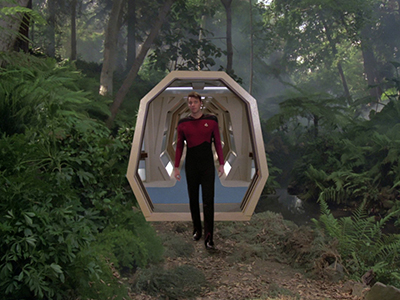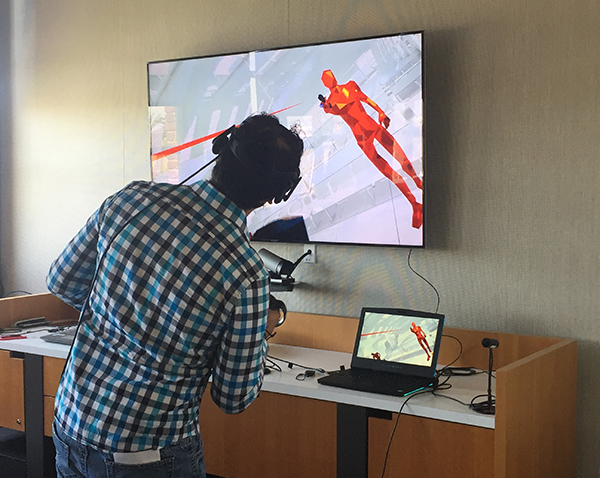The ways we watch films, play games, create content and communicate are changing dramatically as technology catches up with our desire to interact seamlessly with our media. There is a new way to play games that is evolving fast, and we live in the epicenter of its groundbreaking development.

Will Riker (Jonathan Frakes) walks into the
Holodeck on Star Trek: The Next Generation
Virtual reality, or VR, is the newest method of immersion in video gaming that truly puts you "in the game." Science fiction has been exploring the fantasy of digital escapism for decades. Star Trek enchanted audiences with its futuristic "Holodeck," where crew members could walk into a room that could transform into any location they wished. A sunny beach, a familiar restaurant or an epic adventure could be loaded up and experienced as though it were real. Our technology is beginning to live up to this fantasy, and you can already try out the first waves of VR headset devices for yourself.
Something for Everyone
In May, Intel hosted a small technology demonstration in San Francisco, showing off the latest Intel 7th Gen Core processor powered consumer laptops and 2-in-1 device options (2-in-1 refers to a laptop and tablet in one device that can convert to be used as a tablet or a mobile laptop). The processing power required for VR is high, and Intel has been hard at work making their laptop options more lightweight, yet more powerful, maintaining great performance in order to meet the demands of consumers who require increasing levels of mobility, power and efficiency.
There are a lot of great devices powered by Intel 7th Gen Core that are VR ready devices, always connected computers and super thin and light designs. They offer amazing new experiences like immersive VR, high definition 4k video, content creation and streaming, mega-tasking, gaming and more. Here's a breakdown on these series of devices:
 Intel 7th Gen Core Processor "Y-Series" – These devices have ultra low power but have strong performance and are extremely lightweight, and are capable of most basic home-and-office needs. Perfect for basic web or document work on the go and more.
Intel 7th Gen Core Processor "Y-Series" – These devices have ultra low power but have strong performance and are extremely lightweight, and are capable of most basic home-and-office needs. Perfect for basic web or document work on the go and more.
Intel 7th Gen Core Processor "U-Series" – A step up from the Y-series, the U-series models are for heavier workloads, including gaming and more. They boast faster performance and more powerful processing and graphics power.
"Gaming/VR ready" – High-powered gaming/development laptops are on the larger end, in their "extreme" category. These laptops are geared toward high speed and graphics capabilities, satisfying the system requirements for Virtual Reality headsets like the Oculus Rift. This would be the choice for video game developers and gamers wanting to get their heads in VR.
Evolving VR
Virtual reality has had a number of technological hurdles to conquer in its evolution from conception to manufacturing. The headset itself has two screens inside, one for each of your eyes, meaning games have to render twice (two slightly offset perspectives on each eye). In order to prevent motion sickness or sluggish movement, the software has to run at 90 frames per second (that's three times as many frames as most standard televisions and film). This all means that VR games require a lot of power to run, and that's where Intel's high-end processors come in to help.
Diving In Head First
VR also requires space to play and room for the hardware to be set up. Luckily, I was able to try out the Oculus Rift for myself on a high-performance gaming laptop.
 Two sensors (pointed at me) sat at either side of the computer. I had a controller in each hand, and the headset (with a cable running to the computer) went on my head, of course. Once I was set up, I suddenly found myself in another world… Arizona during a zombie apocalypse, to be exact. Turning my head left and right felt natural, leaning my body left and right moved my vision as it should, and I could see digital representations of my hands in front of me as I lifted my controllers up. I looked to my right and saw a table where I could pick up weapons to defend myself against the undead. I looked to my left and saw the zombies approaching, and after I'd dealt with them, I turned around and found more coming at me from behind. The feeling of being immersed in a 3D world was fully realized, and it wasn't until I took the headset and headphones off that I was back in reality.
Two sensors (pointed at me) sat at either side of the computer. I had a controller in each hand, and the headset (with a cable running to the computer) went on my head, of course. Once I was set up, I suddenly found myself in another world… Arizona during a zombie apocalypse, to be exact. Turning my head left and right felt natural, leaning my body left and right moved my vision as it should, and I could see digital representations of my hands in front of me as I lifted my controllers up. I looked to my right and saw a table where I could pick up weapons to defend myself against the undead. I looked to my left and saw the zombies approaching, and after I'd dealt with them, I turned around and found more coming at me from behind. The feeling of being immersed in a 3D world was fully realized, and it wasn't until I took the headset and headphones off that I was back in reality.
Virtual reality is rapidly getting better. I've tried VR headsets in the past, including an early model of the Oculus Rift, as well as the HTC Vive and Playstation VR, and each time I've felt like the technology and the experiences being created have been getting better and better with every boost to speed, visual quality and ergonomic design.
The future is almost here. All you need to do is make sure you have a computer powerful enough to handle it.



